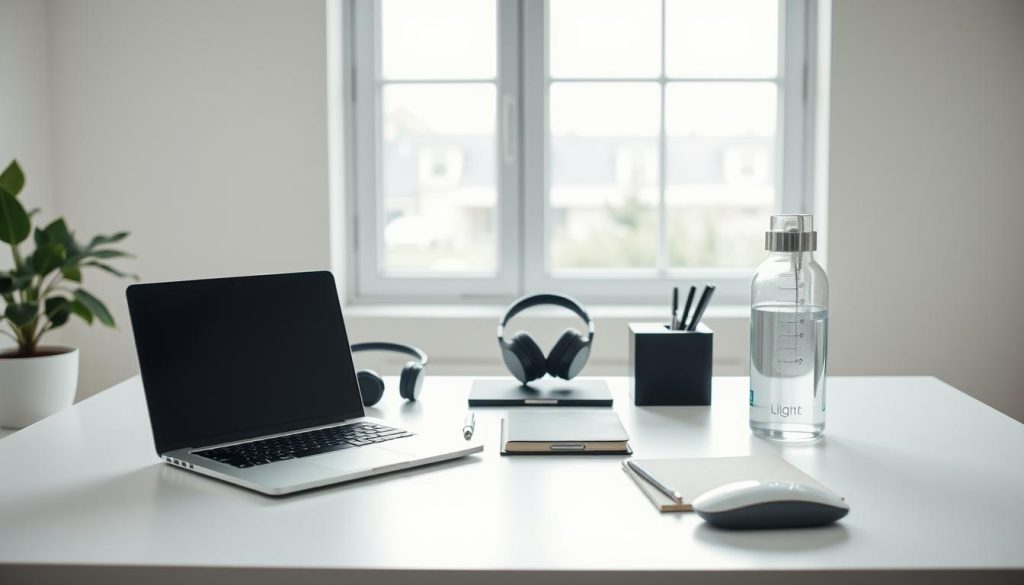In 2020 Aviva found 41% of people chose roles for work-life balance over salary. For a solo entrepreneur in France, that shift matters. It explains why clients now value steady hours and clear expectations.
When Marie, a freelance consultant in Lyon, doubled her hours she felt productive but then lost sleep. UCL research shows people who log 3+ overtime hours face a 60% higher risk of heart issues. That fact changed how she planned her week.
We present a practical, data-backed path you can follow. Expect simple systems — weekly planning, firm boundaries, and recovery rituals sized for one-person businesses. These approaches protect your health and keep your work sustainable.
The goal is clear: help you find balance without sacrificing client delivery or income. We combine current evidence on engagement and health with actionable tips you can apply this week.
Table of Contents
Key Takeaways
- Data shows many now prioritize work-life balance over pay.
- Overtime raises health risks—plan hours to protect energy.
- Simple systems (planning, boundaries, recovery) work for solo firms.
- High engagement links to better performance and income stability.
- Practical tips here fit French market norms and client expectations.
Why work-life balance matters now for solo entrepreneurs in France
Solo entrepreneurs in France now face stronger cultural and legal cues to protect their daily hours. Recent data shows a clear shift: Aviva reports 41% of people now prioritize work-life balance important over salary, up from 36% before the pandemic. That change affects how clients choose partners and how you present your offer.
Health and mental health: UCL found white-collar workers logging 3+ overtime hours had a 60% higher heart risk. For solos, that means respecting hours directly protects your long-term health and prevents burnout.
Productivity and performance: Engagement links to financial results—teams with high engagement saw a 19.2% rise in operating income versus a 32.7% drop for low-engagement peers. The lesson applies to independent workers: steady days and fewer late-night sessions boost focus and quality.
- Overwork raises real health risks; limit extended hours to protect energy.
- France’s “right to disconnect” supports clear client boundaries.
- Reducing evening and weekend spillover improves productivity and performance.
- Respecting your time makes your offer more attractive to employees and partners.
Practical point: Use these facts to explain your working hours and response windows to prospects—this protects your health and stabilizes revenue.
For a short guide on how to present working hours to clients, see our practical tips here: find your ideal work-life model.
work-life balance
Work-life balance for solo entrepreneurs is an intentional allocation of time and energy that sustains revenue and well-being over the long term.
It is not a myth of perfect daily symmetry. Healthy work-life balance accepts rhythms and seasons: intense projects, quieter weeks, and planned recovery. This view keeps you productive without burning mental resources.
Your mind is a core business asset. Good habits protect cognitive performance and decision quality. Clear non-negotiables for personal life and client-facing availability reduce context switching and save time.
- Quick self-audit: note hours worked, peak performance times, and where switching costs occur.
- Document a weekly baseline: deep work blocks, meetings, admin, and recovery slots.
- Iterate with small steps—10% schedule tweaks compound into real gains.
When you present these boundaries to French clients, state professional standards and response windows. That shows reliability while keeping clear limits that help you find balance.
From balance to blending: what “work-life blending” means for solos
Blending work and life can feel liberating, until the freedom becomes an invisible obligation. Many solo entrepreneurs use daytime flexibility to run errands and answer messages later at night. That pattern offers autonomy but also raises new demands on your time and attention.
Freedom versus pressure: when flexibility erodes boundaries
Definition: For a solo, blending means scheduling personal tasks by day and shifting some project work to evenings.
This gives you choice, yet it can create pressure to be always available. Without guardrails, stress rises and the mind tires faster.
Risks to health and focus when work follows you home
Warning signs include mental fatigue, constant device checks, and blurred days off. Even moderate extra hours affect sleep and recovery.
« Small overruns compound: a late evening reply becomes a pattern that steals rest and reduces output. »
When strict separation is still the right call
Separation beats blending for deep craft work, caregiving needs, or clients who value consistent daytime presence. Use strict days when focus and clear windows matter.
- Set fixed hard stops and limited late-hour windows.
- Plan next-day recovery blocks after any evening work.
- Model leadership in proposals and SOWs: state your response hours clearly.
Try a two-week pilot: track hours, energy, and output. If stress or lost focus rises, revert to clearer separation. For practical presentation tips, see find your ideal work-life model.
Plan your week with intention to protect personal life
A deliberate weekly plan keeps your energy high and stops work from expanding into all hours. Start by blocking purpose-driven segments so the week serves your goals and your personal time.
Time-blocking deep work, meetings, and communication
Block your week by intention: reserve AM for deep work, cluster meetings into specific days, and add a single communication window to reduce context switching.
Treat meetings as scarce. Cap daily slots, add buffers, and move nonessential chats to async so your workday stays predictable.
Scheduling joy, recovery, and breaks throughout the day
Dr. Farvah Fatima recommends short breaks every 1–2 hours to boost productivity, focus, and energy. Set timers for 60–90 minute work runs, then step away for 5–10 minutes.
Put personal life on the calendar first. Book workouts, lunch outside, and family time so work expands around what matters, not over it.
- Use templates for recurring days (proposal, delivery, admin) to reduce decision fatigue.
- Schedule micro-recovery: short walks, coffee away from the office desk, quick stretching.
- Reserve a weekly “CEO hour” to review pipeline and adjust blocks for the next week.
Set boundaries on working hours and communication
Defining when you are available is the practical first step to protect your time. Clear limits make your delivery predictable for clients and safeguard your health.
Design a hard stop and end-of-day shutdown ritual
Commit to a hard stop. Pick specific hours (for example 09:30–17:30 CET) and protect them. After your cutoff, run a short shutdown: inbox tidy, three priorities for tomorrow, and a device-free transition activity.
Apply France’s “right to disconnect” as a solo policy
Mirror the law. Treat out-of-hours contact as nonessential. Use scheduled sends and auto-replies after your hours to reinforce this rule. This creates a professional culture that protects your private life.
Client expectations: clear communication and response windows
State response times in contracts: 24 business hours for email, same-day for defined emergencies. List meeting slots and emergency channels up front. Use calendar blocks and call routing to enforce your policy.
- Publish your working hours publicly.
- Schedule personal activity right after work to make the hard stop real.
- Reiterate boundaries when scope shifts and offer alternatives that preserve quality.
Practice leadership on yourself: model the discipline you expect from any team and your clients will respect the limits.
For a deeper guide to presenting hours and policies, see our short resource on work-life balance.
Build a healthy work-life rhythm when working from home

To protect focus and rest, create small routines that mark the start and end of your work time at home.
Create a dedicated workspace and start/stop cues
Designate a specific chair or corner as your office. This visual cue tells your brain when the workday begins and ends.
Use simple start/stop signals: a short walk, changing clothes, or a playlist. These actions help you switch modes and reduce blur between home and work.
Use micro-breaks and movement to maintain energy
Gallup finds many remote people report better work-life balance, yet only a third feel they have a healthy rhythm. Flexibility needs structure.
Take micro-breaks: stand, stretch, hydrate, or walk a few steps every 60–90 minutes. These small pauses cut fatigue and restore energy.
- Keep meetings purposeful; favour async where possible and add margins before calls.
- Separate devices if you can — one for work, one personal — to protect private time.
- Close work tabs and mute notifications during deep focus; reopen them in scheduled windows.
| Practice | Action | Benefit |
|---|---|---|
| Dedicated workspace | Same chair or corner each day | Clear start/stop signal |
| Start/stop cue | Walk, music, or outfit change | Faster mental transition |
| Micro-breaks | Stretch, hydrate, short walk | Less fatigue, steady energy |
Tip: Accept that flexibility is a tool. Your structure converts time at home into real balance.
Prevent burnout with recovery, mindfulness, and time off
Protecting rest is a strategic business choice, not a luxury. Recovery keeps your energy steady and protects health so you can deliver reliably. Data shows nearly 70% of people still work while on vacation, a pattern that fuels chronic stress and reduces effectiveness.
Micro-rest to macro-rest: lunch outside, days off, real vacations
Plan tiers of recovery. Use micro cycles: 60–90 minute work runs with short breaks, as Dr. Farvah Fatima recommends, to boost focus and energy.
- Mezzo: take a proper lunch outside to reset your mind and improve mood.
- Macro: book full days off and real vacations; set an out-of-office and log out of apps to avoid the 70% trap.
- Treat days off with the same discipline as deadlines—hand off contingencies before you leave.
Mindfulness to spot early stress signals and rebalance
Mindfulness helps you notice early stress signs—irritability, skipped meals, shallow breathing—so you can act before burnout starts. Track simple signals weekly: focus, mood, and energy.
« Short rituals—step away, breathe, reset intent—help you return focused rather than pushing through diminishing returns. »
Plan rest like work: book days each quarter, combine sleep and movement with cognitive recovery like reading or nature walks, and normalize rest in client conversations. You will be healthier, more productive, and less likely to face serious burnout.
For extra tips on how to present this to clients, see our short guide: take time effectively.
Tools, habits, and support systems that sustain balance

Practical tools and steady habits are the scaffolding that keep a solo entrepreneur’s day reliable. Use simple systems so your workday becomes predictable and less draining.
Focus and distraction blockers to protect your workday
Use website blockers, scheduled notifications, and single-task timers to protect deep work. These tools reduce context switching and raise overall productivity.
Default to async communication: batch messages and limit live meetings. That creates long, focused runs and protects your best time for high-value tasks.
Coaches, peers, and therapists: when to get help
Professional support accelerates change. A coach or counselor helps you find high-impact shifts and sequence habits that stick.
Build a peer team: mastermind groups or coworking cohorts act like a small team for feedback and accountability. Therapists help when stress affects sleep, mood, or decision-making.
Metrics that matter: tracking hours, energy, and engagement
Instrument your week with three simple metrics: hours worked, energy levels, and engagement markers (enthusiasm or avoidance).
Translate those numbers into action: cut meetings, tighten communication windows, or move demanding tasks to peak energy times.
« Track one metric weekly and one habit monthly; small data guides strong change. »
| Measure | How to track | Action |
|---|---|---|
| Hours worked | Weekly timesheet or app | Set a weekly cap and enforce hard stops |
| Energy level | Daily 1–5 self-rating | Schedule high-energy tasks in morning peaks |
| Engagement | Note enthusiasm vs avoidance | Reassign or batch low-engagement tasks |
| Communication hygiene | Count async vs live interactions | Shift 70% of messages to async |
- Treat yourself as a valued employee: set fair workload, clear goals, and realistic deadlines.
- Level up systems slowly—one habit per week—to raise performance levels without overload.
- Reassess quarterly: keep what works, retire what doesn’t, and adjust tools for changing levels of demand.
Optimize your business model to improve work-life fit
Reframing offers as outcomes, not hours, changes client expectations and preserves your energy.
Shift revenue away from time: productized services, retainers, and clear packages decouple income from hours. This reduces urgent churn and protects deep delivery blocks.
Set intake rules: minimum project sizes and defined intake windows cut context switching. Your calendar gains focus and your work quality improves.
- Price for performance and value, not speed; this aligns clients with higher quality.
- Standardize delivery into clear levels with templates and checklists.
- Offer optional rush fees and explicit limits on after-hours work.
- Bundle meetings as paid strategy sessions; move status updates to async dashboards.
« Structures that emphasize focus and clear expectations drive better outcomes and long-term performance. »
| Change | Action | Benefit |
|---|---|---|
| Productized services | Packaged offers with fixed scope | Predictable income, fewer hourly disputes |
| Delivery levels | Templates, checklists, defined SLAs | Lower cognitive load, repeatable quality |
| Meeting strategy | Paid strategy + async status | Reclaimed time for high-value work |
| Quarterly review | Assess margins and time sinks | Double down on high-margin services |
For practical steps to improve work-life balance in your offers, see our guide: improve work-life.
Conclusion
A single deliberate move—an earlier stop, a deep-work block, or a productized offer—can reset your week.
The evidence is clear: people now value work-life balance more, and long hours harm health. Simple systems turn flexibility into reliable results: plan your week, protect working hours, and schedule real recovery.
Keep the mind sharp with short breaks, device boundaries, and a firm end-of-day ritual. Track basic metrics—hours, energy, and output—and iterate your offers and calendar from that data.
Next step: choose one change today and test it tomorrow. For practical steps on organising time and tasks, see our effective work organisation tips.
FAQ
What does "work-life blending" mean for solo entrepreneurs?
Work-life blending describes a flexible mix of professional tasks and personal activities across the day. For solos, it can offer freedom to choose when to work but also risk of blurred boundaries. We recommend defined windows for focused work and scheduled personal time to keep energy and performance steady.
Why does protecting personal time matter now for independent professionals in France?
Protecting personal time reduces stress and lowers burnout risk while preserving cognitive resources for complex tasks. In France, cultural and legal emphasis on rest supports sustainable productivity — applying those principles personally improves health, client delivery, and long-term income stability.
How can I plan a week that safeguards private life without losing clients?
Use time-blocking: reserve slots for deep work, client calls, and admin. Communicate your availability upfront to clients and set response windows. Schedule recovery and joyful activities as non-negotiable items so they receive the same priority as billable work.
What practical steps create a reliable end-of-day routine?
Implement a hard stop time, an end-of-day checklist, and a short shutdown ritual (review tasks, set tomorrow’s top three, close devices). These cues separate work and home roles, recharging attention for the next day and improving sleep quality.
How should I apply France’s "right to disconnect" as a solo policy?
Adopt it as a personal rule: define no-contact hours, include them in client contracts and email signatures, and set autoresponders outside those times. This signals professionalism and helps you maintain consistent recovery periods.
What are effective micro-breaks when working from home?
Take frequent short pauses: stand, stretch, walk 3–5 minutes, or step outside for fresh air. Micro-breaks restore focus and reduce tension. Pair them with start/stop cues like a brief breathing exercise to mark task transitions.
How can I detect early signs of burnout and act before it escalates?
Watch for chronic fatigue, irritability, reduced concentration, and declining enjoyment. Track hours and energy levels weekly. If patterns show sustained decline, reduce workload, increase restorative activities, and consult a mental health professional or peer coach.
Which tools help protect focus and reduce interruptions?
Use calendar blocking, noise-cancelling headphones, website blockers, and status indicators (Slack/Teams). Combine tools with norms: set meeting-free periods and communicate expected response times to minimize context switching.
When should I involve a coach, peer group, or therapist?
Seek a coach when you need structure to change habits or optimize your business model. Join peer groups for practical accountability. Consult a therapist for persistent stress, sleep issues, or mood changes — early support prevents escalation.
What metrics should I track to assess whether my work and personal life are balanced?
Monitor weekly billable hours, total work hours, sleep quality, and a simple energy rating each evening. Also note time spent on social life and hobbies. These indicators reveal trends and guide adjustments before stress accumulates.
How can I redesign my offers to better fit my personal life?
Consider fixed-fee packages, clearer scopes, limited client intake, or tiered service levels. Automate administrative tasks and delegate where possible. Align pricing with your target working hours so income and lifestyle objectives match.
What habits sustain long-term health and performance for independent workers?
Prioritize consistent sleep, regular physical activity, scheduled days off, and short daily mindfulness or breathing practices. Regular breaks, boundary rituals, and social connections keep motivation high and reduce chronic stress.
How do I manage client expectations about response times and availability?
Set clear expectations in proposals and onboarding: define office hours, response windows, and escalation paths for urgent matters. Use email templates and a professional voicemail message to reinforce those boundaries consistently.
Can strict separation between work and home still be useful?
Yes. For tasks requiring deep concentration or for people who recharge with clear boundaries, strict separation preserves focus and recovery. Choose separation when it improves output and wellbeing, and communicate it to clients and collaborators.





